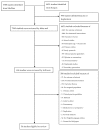Dietary Factors and Risks of Cardiovascular Diseases: An Umbrella Review
- PMID: 32326404
- PMCID: PMC7231110
- DOI: 10.3390/nu12041088
Dietary Factors and Risks of Cardiovascular Diseases: An Umbrella Review
Abstract
Unhealthy diet is a significant risk factor for cardiovascular diseases (CVD). Therefore, this umbrella review aims to comprehensively review the effects of dietary factors, including dietary patterns, food groups, and nutrients on CVD risks. Medline and Scopus databases were searched through March 2020. Systematic reviews with meta-analyses (SRMA) of randomized controlled trials (RCTs) or observational studies measuring the effects of dietary factors on CVD risks were eligible. Fifty-four SRMAs, including 35 SRMAs of observational studies, 10 SRMAs of RCTs, and 9 SRMAs of combined RCT and observational studies, were included for review. Findings from the SRMAs of RCTs suggest the significant benefit of Mediterranean and high-quality diets for lowering CVD risk, with pooled risk ratios (RRs) ranging from 0.55 (95%CI: 0.39-0.76) to 0.64 (95%CI: 0.53-0.79) and 0.70 (95%CI: 0.57-0.87), respectively. For food nutrients, two SRMAs of RCTs found that high intake of n-3 polyunsaturated fatty acid (PUFA) significantly reduced CVD risks, with pooled RRs ranging from 0.89 (95%CI: 0.82, 0.98) to 0.90 (95%CI: 0.85-0.96), while evidence of efficacy of n-6 PUFA and combined n-3 and n-6 PUFA were inconsistent. Moreover, results from the SRMAs of RCTs did not find a significant benefit of a low-salt diet and low total fat intake for CVD prevention. For food groups, results from the SRMAs of cohort studies suggest that high intakes of legumes, nuts, and chocolate, as well as a vegetarian diet significantly reduced the risk of coronary heart disease, with pooled RRs of 0.90 (95%CI: 0.84-0.97), 0.68 (95%CI: 0.59-0.78), 0.90 (95%CI: 0.82-0.97), and 0.71 (95%CI: 0.57-0.87), respectively. Healthy dietary patterns had a significant benefit for CVD prevention. With the substitutional and synergistic interactions between different food groups and nutrients, dietary recommendations for CVD prevention should be focused more on healthy dietary patterns than single food groups or nutrients.
Keywords: cardiovascular disease; dietary factor; umbrella review.
Conflict of interest statement
The authors declare no conflict of interest. The funders had no role in the design of the study; in the collection, analyses, or interpretation of data; in the writing of the manuscript, or in the decision to publish the results.
Figures





References
-
- Wang H., Naghavi M., Allen C., Barber R.M., Bhutta Z.A., Carter A., Casey D.C., Charlson F.J., Chen A.Z., Coates M.M., et al. Global, regional, and national life expectancy, all-cause mortality, and cause-specific mortality for 249 causes of death, 1980–2015: A systematic analysis for the Global Burden of Disease Study 2015. Lancet. 2016;388:1459–1544. doi: 10.1016/S0140-6736(16)31012-1. - DOI - PMC - PubMed
-
- Yusuf S., Hawken S., Ounpuu S., Dans T., Avezum A., Lanas F., McQueen M., Budaj A., Pais P., Varigos J., et al. Effect of potentially modifiable risk factors associated with myocardial infarction in 52 countries (the INTERHEART study): Case-control study. Lancet. 2004;364:937–952. doi: 10.1016/S0140-6736(04)17018-9. - DOI - PubMed
-
- O’Donnell M.J., Chin S.L., Rangarajan S., Xavier D., Liu L., Zhang H., Rao-Melacini P., Zhang X., Pais P., Agapay S., et al. Global and regional effects of potentially modifiable risk factors associated with acute stroke in 32 countries (INTERSTROKE): A case-control study. Lancet. 2016;388:761–775. doi: 10.1016/S0140-6736(16)30506-2. - DOI - PubMed
-
- Sacks F.M., Lichtenstein A.H., Wu J.H.Y., Appel L.J., Creager M.A., Kris-Etherton P.M., Miller M., Rimm E.B., Rudel L.L., Robinson J.G., et al. Dietary Fats and Cardiovascular Disease: A Presidential Advisory From the American Heart Association. Circulation. 2017;136:e1–e23. doi: 10.1161/CIR.0000000000000510. - DOI - PubMed
Publication types
MeSH terms
Substances
Grants and funding
LinkOut - more resources
Full Text Sources

